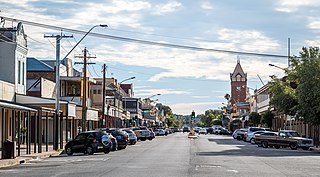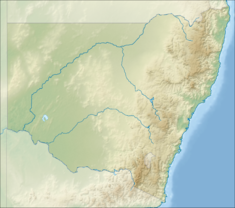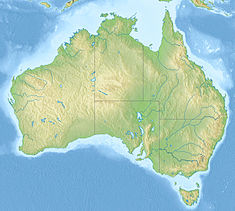
Broken Hill is a city in the far west region of outback New South Wales, Australia. An inland mining city, it is near the border with South Australia on the crossing of the Barrier Highway (A32) and the Silver City Highway (B79), in the Barrier Range. It is 315 m (1,033 ft) above sea level, with a cold semi-arid climate, and an average rainfall of 265 mm (10.4 in). The closest major city is Mildura, 300 km (190 mi) to the south and the nearest State Capital City is Adelaide, the capital of South Australia, which is more than 500 km (310 mi) to the southwest and linked via route A32, the Barrier Highway.

Castlemaine Perkins Building is a heritage-listed former warehouse at 418–420 Adelaide Street, Brisbane City, City of Brisbane, Queensland, Australia. It was designed by Thomas Ramsay Hall and built from 1918 to 1919 by George Albert Baumber and was extended in 1928 to 1929. It is also known as Castlemaine Brewery and Quinlan, Gray & Co Building. It was added to the Queensland Heritage Register on 6 March 2009.

The ASN Co building is a heritage-listed building located at 1–5 Hickson Road, The Rocks, Sydney, New South Wales, Australia. Completed in 1885 and built in the Pre-Federation Anglo Dutch style under the direction of William Wardell and his associate, Walter Liberty Vernon, the building served as the principal offices and warehouse for the Australasian Steam Navigation Company until the company's merger in 1887, when the Government of New South Wales acquired the land used for ordinance facilities and later as government administration offices. Since 1989 the building has been owned by the Sydney Cove Redevelopment Authority and its successors. The building is currently used as an art gallery to display the works of Ken Done.

Broken Hill Post Office is a heritage-listed post office at 258–260 Argent Street, Broken Hill, in the Far West of New South Wales, Australia. The original building was designed by James Barnet, and was built from 1890 to 1892 by John Dobbie. Walter Liberty Vernon designed a telegraph office addition in 1900. The property is owned by Australia Post. It was added to the New South Wales State Heritage Register on 22 December 2000. It was added to the Australian Commonwealth Heritage List on 8 November 2011.

Day Dream Smelter is a heritage-listed former smelter and now archaeological site located on an unnamed road at Broken Hill, New South Wales, Australia, approximately 20 km north-west of Broken Hill town. The property is owned by the Broken Hill City Council. It was added to the New South Wales State Heritage Register on 2 April 1999.

David Cohen & Co. Warehouse is a heritage-listed facade and side wall from a former warehouse at 48–50 Bolton Street, Newcastle, City of Newcastle, New South Wales, Australia. It was designed by Frederick B. Menckens and built from 1901. It now forms part of the Bolton Street Car Park. It was added to the New South Wales State Heritage Register on 2 April 1999.

The Argyle Stores is a heritage-listed former custom house and bond store that now serves as offices, bar, function rooms and restaurant located at 12–20 Argyle Street in the inner-city Sydney suburb of The Rocks in the City of Sydney local government area of New South Wales, Australia. Henry Cooper designed the east wing, and the designer of all other wings is not known. The Argyle Stores were built from 1826 to 1878, and is also known as Argyle Bond Stores and Cleland Bond Store. The property is owned by Property NSW, an agency of the Government of New South Wales. It was added to the New South Wales State Heritage Register on 10 May 2002.

Cleland Bond Store is a heritage-listed former warehouse and bond store and now department store and shops located at 33 Playfair Street in the inner city Sydney suburb of The Rocks in the City of Sydney local government area of New South Wales, Australia. It was built from 1913 to 1914. It is also known as Cleland Bond Store (part of Argyle Stores) and Cleland Store. The property is owned by Property NSW, an agency of the Government of New South Wales. It was added to the New South Wales State Heritage Register on 10 May 2002.

The Old Bushells Factory is a heritage-listed former Bushells Tea factory and warehouse, now used as shops, offices and an art gallery, located at 86–88 George Street in the inner city Sydney suburb of The Rocks in the City of Sydney local government area of New South Wales, Australia. No. 86 was designed by Walter Liberty Vernon; and both buildings were built from 1886 to 1912. It is also known as the Old Bushells Factory and Warehouse; Bushells Place; Bushells Warehouse and Bushells Offices; and Health Commission Building (Bushell's). The property is owned by Property NSW, an agency of the Government of New South Wales. It was added to the New South Wales State Heritage Register on 10 May 2002.

The Raphael Mackeller Stores is a heritage-listed former store and now museum located at 4–6 Kendall Lane in the inner city Sydney suburb of The Rocks in the City of Sydney local government area of New South Wales, Australia. It was built from 1853 to 1854 for Joseph George Raphael. It is also known as The Rocks Toy Museum, Unwin's Coach House, Coach House, and The Coachhouse. The property is owned by Property NSW, an agency of the Government of New South Wales. It was added to the New South Wales State Heritage Register on 10 May 2002.

The Metcalfe Bond Stores is a heritage-listed former bond store and warehouse and now shops and offices located at 68–84 George Street in the inner city Sydney suburb of The Rocks in the City of Sydney local government area of New South Wales, Australia. It was built from 1912 to 1916. It is also known as New Metcalfe Bond Stores. The property is owned by Property NSW, an agency of the Government of New South Wales. It was added to the New South Wales State Heritage Register on 10 May 2002.

Samson's Cottage wall remains is a heritage-listed former residence and now retail building located at 8 Kendall Lane, in the inner city Sydney suburb of The Rocks in the City of Sydney local government area of New South Wales, Australia. It was built for William Samson in 1844. It is also known as Samson's Cottage (wall remains) and Puppet Cottage (Samsons). The property is owned by Property NSW, an agency of the Government of New South Wales. It was added to the New South Wales State Heritage Register on 10 May 2002.

Harrington's Buildings is a heritage-listed hotel and former offices and store located at 53–65 George Street in the inner city Sydney suburb of The Rocks in the City of Sydney local government area of New South Wales, Australia. It was built from 1924 to 1925 by Concrete Constructions Limited. It is also known as Old Sydney Holiday Inn and Old Sydney Park Royal Hotel. The property is owned by Property NSW, an agency of the Government of New South Wales. It was added to the New South Wales State Heritage Register on 10 May 2002.

The Union Bond Store is a heritage-listed former warehouse, bond store and Westpac bank branch and museum located at 47 George Street in the inner city Sydney suburb of The Rocks in the City of Sydney local government area of New South Wales, Australia. It was designed by John Bibb and built from 1841 to 1842. It is also known as Union Bond Store (former) and Westpac Bank. The property is owned by Property NSW, an agency of the Government of New South Wales. It was added to the New South Wales State Heritage Register on 10 May 2002.

The Old Mining Museum building is a heritage-listed former chemical laboratory and mining museum and now commercial building located at 36–64 George Street in the inner city Sydney suburb of The Rocks in the City of Sydney local government area of New South Wales, Australia. It was designed by Walter Liberty Vernon and built from 1902 to 1909. It is also known as Mining Museum (former), Earth Exchange and Sydney Geological and Mining Museum. The property is owned by Property NSW, an agency of the Government of New South Wales. It was added to the New South Wales State Heritage Register on 10 May 2002.

149–151 George Street, The Rocks is a heritage-listed duty-free store complex and former retail building and residence located at 149–151 George Street, in the inner city Sydney suburb of The Rocks in the City of Sydney local government area of New South Wales, Australia. It was built from 1913 to 1913. It is also known as part of the Duty Free Store complex. The property is owned by Property NSW, an agency of the Government of New South Wales. It was added to the New South Wales State Heritage Register on 10 May 2002.

The Oswald Bond Store is a heritage-listed former wool bond store and now offices at 1–17 Kent Street, in the inner city Sydney suburb of Millers Point in the City of Sydney local government area of New South Wales, Australia. It was designed by A. L. & G. McCredie and built by J. R. Locke. It is also known as Hentsch's Bond Store. It was added to the New South Wales State Heritage Register on 2 April 1999.

Grafton Bond Store is a heritage-listed former bond store and warehouse and now offices located at 60 Hickson Road, in the inner city Sydney suburb of Millers Point in the City of Sydney local government area of New South Wales, Australia. The 1881 sections of the building were designed by William Wardell. It was incorporated into the new Maritime Centre in the 1980s. It was added to the New South Wales State Heritage Register on 18 April 2000.

Dalgety's Bond Stores is a heritage-listed former warehouse complex and now commercial building located at Munn Street, in the inner city Sydney suburb of Millers Point in the City of Sydney local government area of New South Wales, Australia. It was built in 1875. It is also known as Munn Street Bond Stores. It was added to the New South Wales State Heritage Register on 2 April 1999.

75–77 Lower Fort Street is a heritage-listed shop and residence located at 75 and 77 Lower Fort Street, in the inner city Sydney suburb of Millers Point, in the City of Sydney local government area of New South Wales, Australia. It was added to the New South Wales State Heritage Register on 2 April 1999.
























